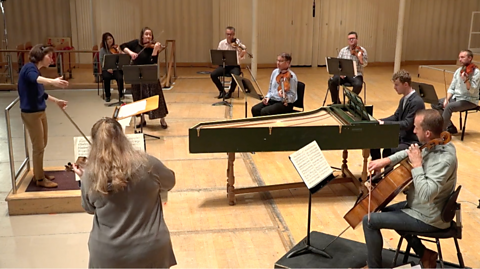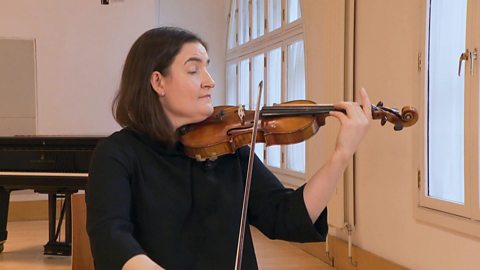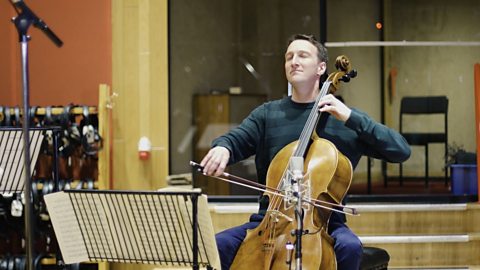Key information
In this guide we will look at a range of key musical concepts relating to melody and harmony, including:
relative major
relative minor
harmonic minor scales
melodic minor scales
modes and modal music
obbligato
acciaccaturas
mordents
Relative major and relative minor
The terms relative major and relative minor are used to described two keys and scales which share all the same notes and the same key signature. This means that it is common to modulate or change key between relative keys.
Example
- C major is the relative major of A minor
- A minor is the relative minor of C major
The scales for these keys include the same notes:
- C major - C, D, E, F, G, A, B (notice that A is the sixth degree (note) on the C major scale)
- A minor - A, B, C, D, E, F, G (notice that C is the third degree (note) on the A minor scale)
Only the order of tones and semitones is different.
Both keys have the same key signature, shown here:.
C major is the relative major of A minor
Because they share the same key signature and the same notes, it is common to modulate or change key between relative keys.
Listen to this audio extract to hear C Major modulating to A Minor. You can follow along with the notation below.
Now listen to A Minor modulating back to C Major. Again, you can follow along with the notation below.
F major and D minor
- F major is the relative major of D minor
- D minor is the relative minor of F major
F major scale
F, G, A, Bâ, C, D, and E (notice that D is the sixth degree (note) on the F major scale)
D minor scale
D, E, F, G, A, Bâ, and C (notice that F is the third degree (note) on the D minor scale)
Both share the same key signature:
G major and E minor
- G major is the relative major of E minor
- E minor is the relative minor of G major
G major scale
G, A, B, C, D, E, and F⯠(notice that E is the sixth degree (note) on the G major scale)
E minor scale
E, FâŻ, G, A, B, C, and D (notice that G is the third degree (note) on the E minor scale)
Both share the same key signature.
Modulating between relative major and minor
It is common to modulate or change key between relative keys.
At the beginning of Hallelujah by Leonard Cohen. In this portion of the song, the key changes from C major to the relative minor key of A minor.
Listen to Mirrors by Justin Timberlake. Here, he uses the key of C minor for the verse, modulating to the relative major key of Eâ major for the chorus and then modulating back to C minor.
In this section of âMirrorsâ, Justin Timberlake modulates from key of Eâ major for the chorus to the relative minor key of C minor for the verse.
Harmonic minor scale
The harmonic minor scale is where the seventh note is raised by a half step:
Listen to the example of a harmonic minor scale.
Melodic minor scale
The melodic minor scale is a minor scale with both the sixth and seventh notes raised by half a step, but only when ascending.
A descending melodic minor scale is identical to a natural minor scale. In the case of A minor melodic, the descending scale comprises all natural notes.
A melodic minor scale
Listen to this example of a melodic minor scale and follow along with the notation below.
The C Melodic minor scale
Composing activity
Modes and modal music
In western music, modal music dates from before the use of scales and keys.
Modes are similar to tonal scales.
In a tonal scale, each note in the sequence is a whole tone different from the next. Each tonal scale starts on a different note.
Modes are sequences where each note is a whole tone different from the next. The difference is that all modes use the same tonal scale but start and end on different notes.
Modes are based on the C major scale, which is made up of the notes C, D, E, F, G, A, B, C
These notes are the basis for seven different modes. Each starts on a different one of these notes:
- Ionian mode - C, D, E, F, G, A, B, C
- Dorian mode - D, E, F, G, A, B, C, D
- Phrygian mode - E, F, G, A, B, C, D, E
- Lydian mode - F, G, A, B, C, D, E, F
- Mixolydian mode - G, A, B, C, D, E, F, G
- Aeolian mode - A, B, C, D, E, F, G, A
- Locrian mode - B, C, D, E, F, G, B
Plainchant
Watch this video of the musical style plainchant
This early church music is modal and there is a single line of melody with voices singing in unison.
Obbligato
This term is taken from the Italian word âoČú±ôŸ±Č”ČčłÙŽÇ°ùČââ and is used to describe an instrumental part which is featured in a piece of vocal music.
Although not as important as the main vocal soloist, the instrumental obbligato is essential to the overall sound.
Listen to the following examples:
Extract from Bach's Cantata BWV 51
Listen to this extract from Handel's aria Let the Bright Seraphim. Look at the score below and you can see the relation between the solo soprano voice and the trumpet obbligato.
An extract from Handel's aria Let the Bright Seraphim
Ornaments
Acciaccatura
Acciaccatura is a type of ornament or grace note which was very popular during the Baroque period. It's an Italian word which translates literally as dent or bruise.
An acciaccatura appears on the stave as a small grace note with a slash through it. It's often referred to as a crushed note.
An acciaccatura looks like this
An acciaccatura sounds like this
Listen to this extract of Flower of Scotland, played with acciaccaturas. You can follow along with the notation below.
- the top line of notation shows how the melody would normally be played
- the bottom line shows how the melody is played here, with acciaccaturas
An example of acciaccaturas as played in the opening bars of Flower of Scotland
Listen to the acciaccaturas contained in the opening bars of Satie's Gnossienne No 1 and follow along with the notation below:
The opening bars of Satie's Gnossienne No 1
Mordent
A mordent is another type of ornament which involves a rapid alteration of a note with the note above or below.
A mordent
Listen to this extract of Flower of Scotland, played with mordents. You can follow along with the notation below.
- the top line of notation shows how the melody would normally be played
- the bottom line shows how the melody is played here, with mordents
Souer Monique, written for harpsichord by Francois Couperin, is heavily decorated with ornaments. Listen out for the use of trills and mordents in this piece of music from the Baroque period.
Quiz
More on Understanding Music
Find out more by working through a topic
- count2 of 16

- count3 of 16

- count4 of 16

- count5 of 16
